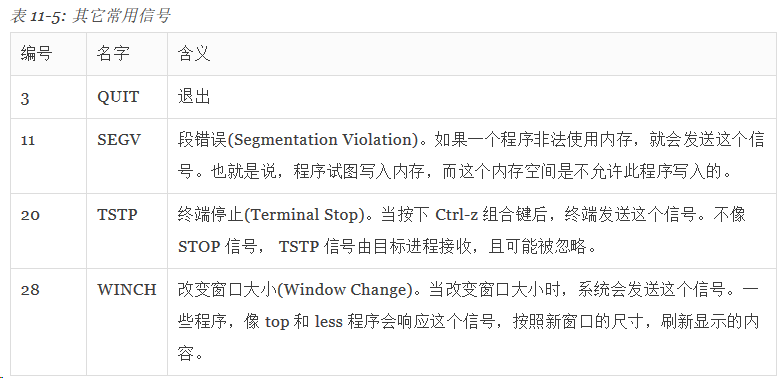(cp https://billie66.github.io/TLCL/book/chap11.html)
While this is all very straightforward, there is more to it than that. The kill command doesn’t exactly “kill” programs, rather it sends them signals. Signals are one of several ways that the operating system communicates with programs. We have already seen signals in action with the use of Ctrl-c and Ctrl-z. When the terminal receives one of these keystrokes, it sends a signal to the program in the foreground. In the case of Ctrl-c, a signal called INT (Interrupt) is sent; with Ctrl-z, a signal called TSTP (Terminal Stop.) Programs, in turn, “listen” for signals and may act upon them as they are received. The fact that a program can listen and act upon signals allows a program to do things like save work in progress when it is sent a termination signal.
虽然这个命令看上去很直白, 但是它的含义不止于此。这个 kill 命令不是真的“杀死”程序,而是给程序 发送信号。信号是操作系统与程序之间进行通信时所采用的几种方式中的一种。 在使用 Ctrl-c 和 Ctrl-z 的过程中我们已经看到信号的实际用法。当终端接受了其中一个按键组合后,它会给在前端运行 的程序发送一个信号。在使用 Ctrl-c 的情况下,会发送一个叫做 INT(Interrupt,中断)的信号;当使用 Ctrl-z 时,则发送一个叫做 TSTP(Terminal Stop,终端停止)的信号。程序,相应地,监听信号的到来,当程序 接到信号之后,则做出响应。一个程序能够监听和响应信号这件事允许一个程序做些事情, 比如,当程序接到一个终止信号时,它可以保存所做的工作。
kill + pid:kill [-signal] PID...如果在命令行中没有指定信号,那么默认情况下,发送 TERM(Terminate,终止)信号。kill 命令被经常用来发送以下命令


